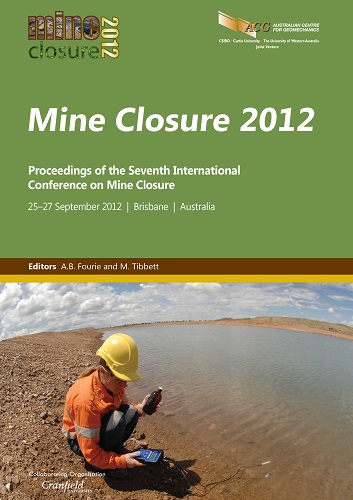Mt Kembla Mine rehabilitation and memorial pathway: a case study of effective stakeholder engagement to ensure successful final land use planning and environmentally and socially sensitive project outcomes

|
Authors: Larance, AJ |
DOI https://doi.org/10.36487/ACG_rep/1208_61_Larance
Cite As:
Larance, AJ 2012, 'Mt Kembla Mine rehabilitation and memorial pathway: a case study of effective stakeholder engagement to ensure successful final land use planning and environmentally and socially sensitive project outcomes', in AB Fourie & M Tibbett (eds), Mine Closure 2012: Proceedings of the Seventh International Conference on Mine Closure, Australian Centre for Geomechanics, Perth, pp. 731-746, https://doi.org/10.36487/ACG_rep/1208_61_Larance
Abstract:
This project represents an innovative approach to mine rehabilitation and beneficial final land use of a degraded mine site where social, environmental and economic values are strengthened in the outcomes. BHP Billiton Illawarra Coal provided the commitment and Cardno Pty Ltd the supporting concept design, planning, and engineering expertise to ensure effective mine rehabilitation techniques to culminate in a stable, non-polluting and long term sustainable site that will allow future mining lease relinquishment. A multi-stage project known as the ‘Mt Kembla Mine Memorial Pathway’ has been planned and developed along a section of the original train haulage route from the historic Mt Kembla and Nebo Colliery sites to the Port Kembla steelworks. A major aim for the site was to sympathetically commemorate Australia’s most significant mine disaster. In 1902 a total of 96 miners lost their lives when a gas explosion occurred within a mine portal situated above the small coal mining village of Mt Kembla in the foothills of the Illawarra Escarpment, just west of Wollongong in New South Wales, Australia (NSW). The project planning and design team were committed to providing a community focused recreational pathway, heritage interpretation area and small scale residential subdivision that was sympathetic to the natural and built environment. Stage 1 of the project was completed in 2008 and Stage 2 of the project commenced planning in 2010 with all development approvals being issued in February 2012. The project planning constraints were complex and an array of future land uses were proposed including private, public recreation and environmentally sensitive spaces. A range of specialists undertook site investigations and design activities to identify constraints and opportunities. A well resolved landscape design was developed that satisfied all local Council planning approvals and mining lease requirements. Community engagement played an integral role in the planning and development. An inclusive approach was undertaken whereby community needs, ideas and concerns were incorporated directly into the concept site layout designs and a final preferred landform design. Community members are now able to tangibly recognise their input into the design in Stage 1 and will see many of their ideas eventuate as Stage 2 construction is completed. Improved environmental values have also been integral to the rehabilitation of the ex-mining land. The rehabilitation works improve the ecological health of the natural environment and creek system, and improve the habitat for flora and fauna. This has been achieved through stabilisation and erosion control of steep rail cuttings and creek banks and restoration of the ecological connectivity of fragmented riparian zones through native vegetation establishment. Whilst the formal ownership of Stage 1 of the pathway was dedicated to local Council as public open space, much of the maintenance of site vegetation and infrastructure is undertaken by Illawarra Coal and local residents who have taken pride and ‘ownership’ of the area due to their involvement in the design and construction process. To date there has been limited financial obligations on the site owner for site enhancements and ongoing maintenance as the community has actively sought voluntary assistance, grants and donations to finance these parts of the project. It is likely that similar on-ground community involvement will also occur in Stage 2. This project serves as a working and innovative example of how an ex-mine site can achieve beneficial outcomes for multiple parties whilst responsibly maintaining and fostering important community values.
References:
Cardno Pty Ltd (2011) Statement of Environmental Effects, Proposed Mine Rehabilitation Works, Mt Kembla Mine Memorial Pathway (Stage 2) and 4 Lot Residential Subdivision, Kirkwood Lane, Mt Kembla, Prepared for BHP Billiton Illawarra Coal, March 2011.
Cardno Pty Ltd and Southern Habitat Pty Ltd (2011) Vegetation Management Plan, American Creek Rehabilitation Works, Prepared for BHP Billiton Illawarra Coal, March 2011.
Department of Environment and Resource Management (2011) Rehabilitation Requirements for Mining Projects, Queensland Department of Environment and Resource Management, March 2011, viewed 04/05/2012, .
Department of Sustainability and Environment (2004) Effective Community Engagement, Version 2, viewed 23/04/2012, .
Douglas Partners (2011) Report on Geotechnical Investigation, Proposed Rehabilitation and Subdivision, Stones Road and Kirkwood Place, Mount Kembla, Prepared for Cardno Pty Ltd, March 2011.
Environment Australia (2002) Overview of Best Practice Environmental Management in Mining, viewed 23/04/2012, .
Rogers, B. (2005) Heritage and Archaeological Assessment of Certain Colliery Railway Land at Mt Kembla, Proposed Rezoning Application, BHP Billiton Land, Kirkwood Place, Mount Kembla, City of Wollongong, Prepared for BHP Billiton, March 2005.
Wollongong City Council (2009) Wollongong Local Environment Plan 2009, Under the Environmental Planning and Assessment Act 1979 (2010 No 76).
© Copyright 2025, Australian Centre for Geomechanics (ACG), The University of Western Australia. All rights reserved.
View copyright/legal information
Please direct any queries or error reports to repository-acg@uwa.edu.au
View copyright/legal information
Please direct any queries or error reports to repository-acg@uwa.edu.au